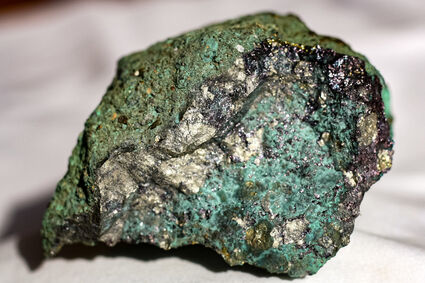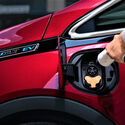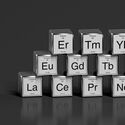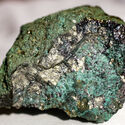Once in a century opportunity for Alaska
A small window exists for Alaska to leverage its vast potential to fill the coming demand for EV, renewable energy metals North of 60 Mining News – March 26, 2021
Last updated 4/29/2021 at 4:13pm

Adobe Stock
It has been estimated that the global shift to low-carbon energy and electric mobility will create nearly $23 trillion in market opportunities over the next decade alone.
From a world-class graphite deposit in the Northwest to rare earths on the Southeast Panhandle, Alaska has the potential to offer a sustainable and secure supply to meet the coming explosive demand for the minerals and metals crucial to the renewable energy and electric vehicle sectors in North America and around the globe.
International Finance Corporation, part of the World Bank Group, estimates that this shift to low-carbon energy and electric mobility will create nearly $23 trillion in market opportunities over the next decade alone.
The window is small, however, for Alaska to leverage its vast mineral wealth to fully take advantage of this one-in-a-century retrofit of global energy and transportation infrastructure.
"There are moments in history when everything changes. Inflection points. We believe such a point is upon us for the mass adoption of electric vehicles," General Motors Global Chief Marketing Officer Deborah Wahl said in January. "Unlike ever before, we have the solutions, capability, technology and scale to put everyone in an EV."
Toward this end, GM has committed to investing $27 billion in electric and autonomous vehicle products over the next five years and plans to have 30 new EV models on showroom floors by the end of 2025.
Volkswagen, considered the frontrunner for overtaking Tesla when it comes to EV production, recently placed an order for $14 billion worth of batteries and plans to build six giga-scale battery facilities in Europe to help power the roughly 26 million electric cars over that span.
In addition to Tesla's success in its push to make EVs mainstream, aggressive government climate policies are playing a large role in nearly every major automaker pushing to transition their vehicle production to mostly or entirely electric in the next 10 to 15 years.
In a move that was hailed as a win by every segment of the American clean energy supply chain – from mining companies positioned to feed rare earths and battery metals into the front end to the automotive giants that will need enormous new supplies of those critical minerals to manufacture a new generation of electric mobility – President Joe Biden signed an executive order that instructs federal agencies to investigate what needs to ensure a strong and reliable supply of the materials to the lower carbon energy future envisioned.
"Resilient, diverse, and secure supply chains are going to help revitalize our domestic manufacturing capacity and create good-paying jobs," Biden said before signing the "Executive order on America's Supply Chains" on Feb. 24.
The aggressive global push for electric mobility and the renewable energy and charging infrastructure needed to fill EV "tanks" with low-carbon electricity will require a massive amount of new metal supplies.
Alaska hosts vast potential for battery materials such as cobalt, graphite, nickel, and vanadium; renewable energy ingredients such as germanium, rare earths, rhenium, silver, and tellurium; as well as the copper and zinc that will be needed in vast quantities in this transition.
With mining projects in the U.S. often taking seven to 10 years to permit and another two to four years to develop, not accounting for the time it takes to explore and design a mine, the runway for feeding Alaskan minerals and metals into these supply chains can be long.
"The mining industry lives on geological time scales, compared to battery industry, so these are decades long planning processes," said Benchmark Mineral Intelligence Managing Director Simon Moores, an expert on global mines-to-batteries supply chains.
While Moores was referring to the battery sector planning ahead to secure raw materials, jurisdictions and mining projects around the globe are racing to meet the tectonic shift in demand for energy elements that will begin tapering off after the first generation of the metal-intensive renewable energy products and EVs begin to be recycled back into the economy.
Battery metals
While on the surface EVs are made up of the same steel, aluminum, polymers, and other materials that are used to build standard internal combustion engine vehicles, the batteries that power them and the motors that drive them require minerals and metals that were not previously mined at the massive scale needed for the electric mobility revolution.
Lithium-ion batteries, which are the EV equivalent to an ICE gas tank, are driving massive new demand for lithium, cobalt, graphite, and nickel.
Benchmark Minerals is tracking nearly 200 battery manufacturing factories in the pipeline around the world with the capacity to produce at least 3.3 terawatt-hours of battery storage capacity per year by 2030, which is more than a 1,250% increase over 2020. By 2040, Benchmark expects the storage capacity of battery cells produced worldwide to increase by a staggering 4,200%.
While the demand for this amount of EV battery storage is being ascertained by the electric transformation of automakers, where the raw materials to feed into the battery supply chains comes from is less clear.
Caspar Rawles, the head of price assessment at Benchmark Mineral Intelligence, told Data Mine North that low minerals and metals prices have stifled investments into the mine projects required to adequately feed the lithium battery supply chains.
"We see key battery raw material markets falling into deficit, most imminently cobalt, but (also) lithium, graphite, and nickel over the coming years," he penned in a Jan. 19 email.
Alaska happens to be home to a world-class sized deposit of graphite nearing the permitting stage and a cobalt-enriched copper deposit in the advanced exploration stage.
With the average EV currently needing roughly 100 pounds of graphite in the battery, the demand growth for this material is enormous.
The World Bank forecasts that low-carbon energy technologies alone will require 4.5 million metric tons of graphite per year by 2050, which is more than triple the amount of this carboniferous material used by all sectors globally in 2020.
With more than 8 million metric tons of graphite in a deposit that averages roughly 8% graphitic carbon, Graphite One Inc.'s Graphite Creek project in western Alaska could feed this battery material into U.S. supply chains for decades.
A 2017 preliminary economic assessment detailed plans for a mine at this world-class deposit that would produce roughly 60,000 metric tons of 95% graphite concentrate per year and a separate processing facility to refine these concentrates into 41,850 metric tons of the coated spherical graphite used in lithium-ion rechargeable batteries and 13,500 metric tons of purified graphite powders annually.
Thanks to a nomination letter by Alaska Gov. Mike Dunleavy, the U.S. Federal Permitting Improvement Steering Council (FPISC) recently designated Graphite Creek as a high-priority infrastructure project.
This designation means the world-class graphite project qualifies for Fast-41 – short for Title 41 of the Fixing America's Surface Transportation Act – a program aimed at improving the timeliness, predictability, and transparency of the federal environmental review and authorization process for domestic infrastructure projects.
FPISC, an independent federal entity created to coordinate the permitting of eligible Fast-41 projects across different federal agencies, informed Graphite One of its eligibility for the streamlining program on Jan. 15.
Graphite One is also encouraged by the Biden administration's recognition of the importance of a reliable supply of graphite and other minerals to the renewable energy and EV revolution.
"Graphite One welcomes the recognition of renewable batteries, and EV batteries in particular as a critical supply chain," Graphite One CEO Anthony Huston commented on Biden's supply chain executive order. "The fact that graphite is essential to three critical supply chains named in the executive order underscores the importance of Graphite One's supply chain approach."
A pre-feasibility for the Graphite One project is expected by mid-year, which will advance the project one step closer to permitting and potentially feeding graphite into North American battery supply chains.
EV batteries are expected to drive massive growth for cobalt, from the current rate of 127,000 metric tons per year to 507,000 metric tons annually by 2050.
With roughly 70% of the world's cobalt currently coming from the Democratic Republic of Congo, a country that has been criticized for unsafe work conditions and human rights violations, EV and battery manufacturers not wanting to be seen as contributing to the endangerment of children in an effort to lessen mankind's carbon footprint are looking for alternatives.
Alaska's most advanced source of cobalt is found at Bornite, a large deposit of high-grade copper being advanced by Ambler Metals, a joint venture company owned equally by Trilogy Metals Inc. and South32 Ltd.
Situated on lands owned by NANA Regional Corp., the Alaska Native Claims Settlement Act (ANCSA) regional corporation for Northwest Alaska, Bornite hosts roughly 6.4 billion pounds of copper and 77 million lb of cobalt, both critical to renewable energy and EVs.
Bornite also carries at least two other critical minerals – germanium and gallium – though the concentrations and recoverability of these technology metals have yet to be determined.
While Bornite is in the advanced exploration stage, it is in queue behind the Arctic copper-zinc-gold-silver project about 16 miles away.
Base metals
It does not matter which battery chemistries are used to power tomorrow's electric vehicles or which renewable energy solutions are used to recharge those EVs, an electric-centric future will require more copper and zinc – a lot more.
While these base metals are abundant and already mined at an industrial scale to meet society's everyday demands, the envisioned low-carbon future is expected to put major strains on global markets for these basic building blocks of the low-carbon future.
This is especially true for copper. Renewable energy generation, EV, and the charging infrastructure for electric mobility all require much more copper than the combustion vehicles, power plants, and filling stations they are replacing.
It is estimated that the average fully electric car contains around 180 lb of copper, which is roughly four to 10 times more than the 18-49 lb in a conventional internal combustion vehicle.
Renewable energy power generation, such as solar and wind, requires approximately five metric tons of copper for every megawatt-hour of electric generation, which is around five times more than traditional coal and natural gas power sources.
To put this in perspective, the World Bank estimates that the green energy transition alone will require roughly 550 million tons of copper over the next 25 years, which is about the same amount humankind has produced in the past 5,000.
As a result, metal and mining market analyst CRU Group forecasts a 4.7-million-metric-ton-per-year shortfall in copper supplies by 2030, a deficit that could be as high as 10 million metric tons if no new mines are developed in the coming decade.
While Alaska does not currently have an operating copper mine, it is a past supplier of this critical electric conductor and has billions of pounds in deposits ready to deliver this green metal to world markets in the coming years.
Porphyry deposits, which are typically relatively low-grade but large, supply the bulk of the world's newly mined copper. And Alaska hosts the largest undeveloped porphyry copper deposit known to exist on Earth – Pebble.
According to resource calculation updated earlier this year, Pebble hosts 6.5 billion metric tons of measured and indicated resources averaging 0.4% (57 billion lb) copper, 0.34 grams per metric ton (71 million ounces) gold, 240 parts per million (3.4 billion lb) molybdenum, 1.7 g/t (345 million oz) silver and 0.41 ppm (2.6 million kg) rhenium.
The Southwest Alaska deposit hosts another 25 billion lb of copper in the lower confidence inferred resource category.
The USGS also believes Pebble hosts an "enormous tellurium endowment at the Pebble" but a resource has not been calculated to quantify this critical solar panel metal.
Pebble Partnership, the company advancing this world-class porphyry deposit, is currently appealing a federal decision to deny the permits needed to develop a mine at this controversial project that would produce 5.74 billion lb of copper, 6.4 million ounces of gold, 260 million lb of molybdenum, and 32 million oz of silver over a 20-year mine life.
Much like copper, demand for zinc is expected to more than double, from current levels of around 12 million metric tons per year to roughly 26 million metric tons per year over the next three decades.
While zinc is not traditionally considered an energy metal, this galvanizing metal will be needed to build every aspect of the envisioned low-carbon infrastructure and has emerged as an ingredient in a revolutionary way to store energy at the utility scale.
Known as zinc-air energy storage, this breakthrough technology uses zinc particles to store energy from renewable and other sources and then delivers electricity to the grid as needed.
While not as widely known as the more common lithium-ion or vanadium redox batteries, zinc-air energy storage systems are already being deployed for utility-scale storage in New York and Australia.
With Teck Resources' Red Dog Mine in the northwest corner of the state contributing roughly 4% of worldwide zinc production and zinc byproducts at Hecla Mining's Greens Creek silver operation on the Southeast Panhandle contributing to the statewide total, Alaska is a major global exporter of this galvanizing and energy-storing metal and has the potential to contribute even more in the coming years.
According to a 2020 feasibility study, a mine at Ambler Metals' Arctic deposit would produce 2.3 billion lb of zinc, 1.9 billion lb of copper, 388 million lb of lead, 386,000 oz of gold, and 40.6 million oz of silver over an initial 12-year mine life.
Ambler Metals is expected to submit applications for the federal permits needed to develop a mine at Arctic during the second half of this year.
Constantine Metal Resources (51%) and Dowa Metals & Mining (49%) are closing in on permitting at Palmer, a Southeast Alaska project that hosts a copper-zinc-gold-silver deposit similar to Arctic.
A 2019 preliminary economic assessment outlined plans for a 3,500-metric-ton-per-day mill at Palmer that would produce 1.07 billion lb of zinc, 196 million lb of copper, 18 million oz of silver, 91,000 oz of gold and 2.89 million metric tons of barite over an initial 11-year mine life.
The Palmer partners are working to secure permits for underground development needed to further expand and upgrade the deposits ahead of more detailed engineering studies.
Energy elements
Renewable energy and electric mobility technologies are also driving unprecedented demand for a wide variety of other elements that were previously only needed in small quantities.
Rare earths used in EVs and wind power generation; gallium, germanium, indium, and tellurium for solar power; and vanadium used for renewable energy storage are among the energy elements that are listed as critical minerals in the United States, European Union, and Canada.
And Alaska currently produces or has the potential to produce all these critical energy elements.
Rare earths have garnered a lot of critical minerals attention in recent years due to their unique properties that enhance high-tech applications and China's near-monopoly on the production of this group of 17 elements.
Evaluating U.S. demand for 52 mineral commodities over a decade beginning in 2007, the U.S. Geological Survey found that six rare earths – dysprosium (No. 1), yttrium (No. 2), neodymium (No. 3), lanthanum (No. 5), cerium (No. 6) and praseodymium (No. 12) – among 23 commodities needed by America's manufacturing sector are most at risk to supply disruptions.
Ucore Rare Metals Inc.'s Bokan deposit in Southeast Alaska is a potential domestic source of the entire suite of rare earth elements, along with six other minerals that have been deemed critical to the United States.
According to a calculation completed in 2019, the Dotson Ridge deposit at Bokan hosts 4.79 million metric tons of indicated resource averaging 0.6% (31,722 metric tons) rare earth oxides, 460 parts per million (2,205 metric tons) niobium; 1,880 ppm (9,001 metric tons) zirconium; 48 ppm (231 metric tons) beryllium; 37 ppm (178 metric tons) hafnium; 0.37% (17,715 metric tons) titanium dioxide; and 97 ppm (464 metric tons) vanadium.
Bokan, however, will likely not be the first Ucore initiative to produce rare earths in Alaska. This is because the company first plans to build a commercial-scale rare earths separation facility at Ketchikan, a port town about 35 miles from Bokan.
This Alaska Strategic Metals Complex, or Alaska SMC, would initially separate mixed rare earth concentrates from U.S.-allied suppliers into commercial purity REE oxides, with a focus on the REEs used in the high-power magnets that make EV motors and wind turbine generators more efficient.
In January, senior management from Ucore presented an overview of the Alaska SMC project to the board of the Alaska Industrial Development and Export Authority (AIDEA), a quasi-state-owned corporation established by the Alaska Legislature in 1967 to advance economic growth and diversification in the state by providing various means of financing and investment.
In 2014, the Alaska Legislature authorized AIDEA to invest up to US$145 million to help finance the development of a mine at Bokan Mountain and Alaska SMC.
Following Ucore's presentation, the AIDEA board unanimously authorized a cost-reimbursement agreement for activities related to the development and operation of the Alaska SMC. The next steps are to formalize the due-diligence process with an AIDEA-retained independent consultant and to proceed with the AIDEA review process through the second quarter of this year.
"Responsible economic resource development is the common goal of both AIDEA and Ucore, and the Alaska SMC facility is the gateway component to establishing environmentally sound, cost-efficient rare earth element supply chain development and commercialization in Southeast Alaska," said Ucore Rare Metals COO Mike Schrider.
Priming the circular economy
While recycling will eventually fill large portions of the world's EV and renewable energy mineral needs, it is initially going to take large-scale mining to feed EV markets with enough minerals and metals to prime this circular economy.
Alaska Gov. Mike Dunleavy says America's Last Frontier stands ready to provide a domestic source of the mined materials needed for the coming energy and transportation revolution.
"Alaska has nearly all the minerals & rare earths needed to provide a domestic supply for EV manufacturers," Gov. Dunleavy posted in a tweet directed at President Biden following reports that the U.S. Department of Commerce held closed-door talks with Canadian officials about sourcing EV minerals and metals.
A March 18 Reuters article said, "Washington is increasingly viewing Canada as a kind of '51st State' for mineral supply purposes and plans to deepen financial and logistical partnerships with the country's mining sector over time, according to a U.S. government source."
Dunleavy questions the logic of this when the administration could further spur America's economy by focusing on the mineral wealth in the 49th State.
"@POTUS, why would you send jobs & investments to Canada, when we can do this in the USA?" the Alaska governor queried in his tweet.
The massive need over the coming three decades, however, offers enormous opportunities for both America's 49th State and adopted 51st State.
Just a week before this meeting that also included Tesla and other big players along the U.S. EV supply chains, Canada published a list of 31 critical minerals.
"The 31 critical minerals on Canada's list are used to develop clean technologies, from solar panels to EV batteries. They're all essential to lowering emissions, increasing our competitiveness, and strengthening our energy security," said Canada Minister of Natural Resources Seamus O'Regan.
While this catalog hosts many of the usual critical mineral suspects – cobalt, graphite, lithium, rare earth elements, and a majority of the other minerals and metals considered critical to both the U.S. and Europe – Canada's critical minerals inventory also includes copper, nickel, and zinc – base metals that are fundamental to building the green energy future but are more readily available than the more traditional critical minerals.
"These minerals and metals are essential to lowering emissions, they are essential to net-zero by 2050; they are essential to our economic competitiveness and our energy security; they meet the needs of our partners and the demands of emerging global trends," O'Regan said.

Shane Lasley
A sample of copper- and cobalt-rich mineralization from the Bornite deposit on Ambler Metals' Upper Kobuk Mineral Projects in Northwest Alaska.
Early last year, Canada and the U.S. finalized a joint action plan to collaborate on securing supply chains for the critical minerals needed for EVs, renewable energy, high-tech, aerospace, defense, and other important sectors of the neighboring countries' economies.
Despite looking to Canada to help supply the explosive growth of minerals and metals to feed into America's renewable energy and EV supply chains, the Biden administration has indicated a desire to foster domestic mining of critical minerals.
"America is in a race against economic competitors like China to own the EV market – and the supply chains for critical materials like lithium and cobalt will determine whether we win or lose," said U.S. Secretary of Energy Jennifer Granholm. "If we want to achieve a 100% carbon-free economy by 2050, we have to create our own supply of these materials, including alternatives here at home in America."























Reader Comments(0)